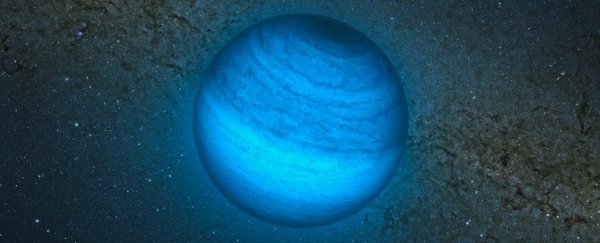Back in 2012, astronomers spotted a perplexing isolated object in our galactic neighbourhood - an object more massive than Jupiter, that looked very much like one of the closest rogue planets we'd ever found. The only problem was, it wasn't like any rogue planet we'd previously seen.
Now scientists has investigated the strange object, known as CFBDSIR 2149-0403, and found evidence that it might not actually be a planet after all, and it's more 'rogue' than we expected.
Although most planets are found neatly orbiting a host star, in recent years it's becoming increasingly common for scientists to detect the occasional 'rogue planet' - a planet that's either been kicked out of its star system, or never had one in the first place, and is now orbiting the entire galaxy.
When researchers found CFBDSIR 2149-0403 back in 2012, they were particularly excited, as it appeared to be the closest rogue planet we'd ever detected, at just a little over 100 light-years away.
It's always hard to determine whether these rogue planet candidates are actually planets, as opposed to brown dwarfs - substellar objects that are heavier than the heaviest planets in the known Universe, but lighter than the lightest stars, and don't quite have enough mass to sustain nuclear fusion.
But based on what researchers could tell about CFBDSIR 2149-0403 at the time, they concluded that it had a mass roughly four to seven times that of Jupiter, making it a rogue planet candidate (the lower cut-off for brown dwarfs is more than 13 times more massive than Jupiter).
It was also suggested that the supposed rogue planet was most likely travelling as part of something called the AB Doradus moving group - a group of objects orbiting our galaxy together that all are roughly the same age, and therefore most likely formed in the same location.
Based on that assumption, CFBDSIR 2149-0403 was predicted to be a relatively young 50 to 120 million years old.
The only problem with the assumption that CFBDSIR 2149-0402 was a rogue planet was that it was based soley on a handful of initial observations.
The conclusion wasn't widely accepted by the scientific community - especially since there was also no evidence that the object had formed as a planet and been objected from any star system.
To figure out what was really going on, a team of researchers led by Philippe Delorme from the Grenoble Alpes University in France, one of the astronomers to first find CFBDSIR 2149-0403, observed the object over the past few years, using multiple telescopes across multiple wavelengths.
And it turns out the object is even weirder than initially thought.
First off, based on the new observations, the team got a more precise estimation of its location and where it's travelling, and concluded that CFBDSIR 2149-0403 can't be part of the AB Doradus moving group.
"Our new … parallax and kinematics safely rule out membership to any known young moving group, including AB~Doradus," the team writes in pre-print journal arXiv.org.
That's both good and bad news for classifying what the object actually is, because although it gives us new information, it also removes the age constraints that were previously in place.
"Though determining that certainly improved our knowledge of the object it also made it more difficult to study, by adding age as a free parameter," Delome told Tomasz Nowakowski from Phys.org.
The team also discovered that the object either has low gravity, or unusually high metal content, referred to as high metallicity. And the new observations made them less certain of the object's mass, which means they can no longer say confidently that it's a planet rather than a brown dwarf.
Based on these findings, we're left with two hypotheses: CFBDSIR 2149-0403 is either a young (less than 500 million years old) rogue planet, between two and 13 times the mass of Jupiter; or it's an older (2 to 3 billion years old) highly metallic brown dwarf, with a mass ranging from two to 40 times the mass of Jupiter.
Or maybe it's something else entirely.
"CFBDSIR 2149-0403 is an atypical substellar object that is either a 'free-floating planet' or a rare high-metallicity brown dwarf. Or a combination of both," Delorme told Phys.org.
The results have been published on pre-print site arXiv.org ahead of peer-review, so until we have others in the astronomy community scrutinise and independently verify them, we need to be skeptical.
But the good news is that CFBDSIR 2149-0403 is relatively close to us, so we can continue to observe it to gain a better understanding of the nature of rogue planets or brown dwarfs.
And it might even be our first chance to study a whole new class of planet-like object we haven't yet defined.
You can read the full paper over at arXiv.org.
